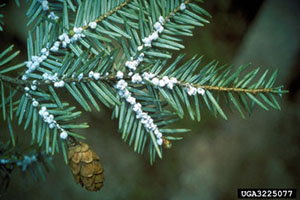Common Issues in the Landscape: Hemlock Pests
In this area of New England there are two primary pests associated with the decline of hemlocks. In addition to those two key pests, there are a range of other less common or secondary pests that can attack an already stressed tree and do extensive damage if left untreated.
Hemlock Woolly Adelgid
Easily one of the most recognized tree pests around is the hemlock woolly adelgid, characterized by the mini cotton ball looking egg masses found at the base of the needles. This insect is responsible for major decline of the hemlock population in the eastern United States. Thankfully control of this insect in a residential setting is quite easy and should be no problem keeping under control as long as it doesn’t go undetected for too long.
Hemlock Elongate Scale
Second, and possibly more destructive in a landscape setting is the elongate hemlock scale. While this armored scale insect can be found on any hemlock at any time, it tends to move in after the woolly adelgid has been treated. Since the trees are being treated, the changeover in insects tends to go unnoticed until the continued decline is taken into account and the new pest is identified. The scale is much more resilient than the adelgid, and will require a different treatment plan for effective control.
Be aware that hemlocks that have been treated with the product imidacloprid for control of adelgid can be prone to spider mite outbreaks, so be mindful of that possibility. Lastly, hemlock trees are notorious for not handling drought stress very well. Some proactive measures may need to be taken to assist drought stressed trees and avoid decline.
Keep a close eye on your trees and contact a local certified arborist at the first sign of any of these things. As with any issue, early detection always gives the best chance in maintaining tree health.


